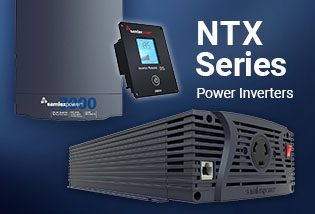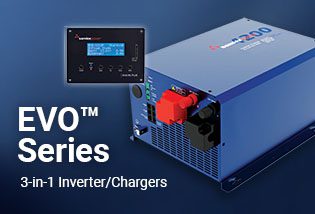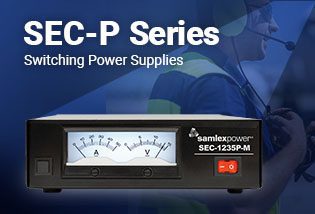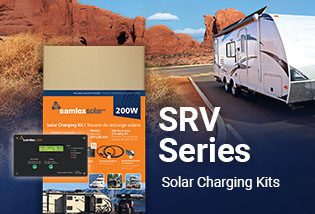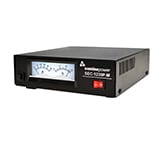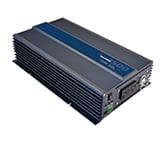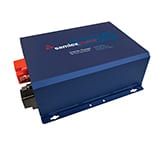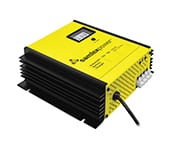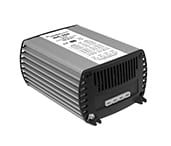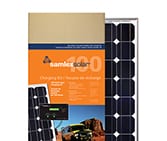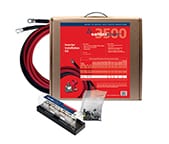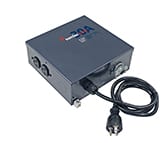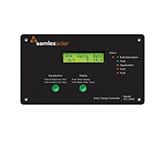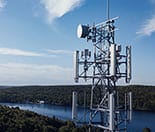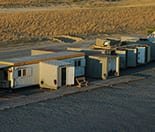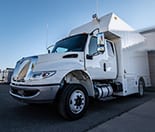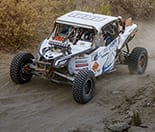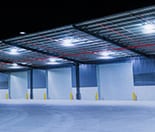Inverters: General Information
What is a DC-AC inverter?
When you plug anything into the wall in your home you are usually “plugging in” to the power-grid provided as a service by your utility company. Your utility company supplies you with alternating current (AC) electricity. AC electricity flows in alternate directions many times per second. AC is used for utility grid service because it is more practical for long distance transmission.
Batteries provide direct current electricity (DC) electricity which flows in a single direction. DC power is what is used in many electronics in the home like laptops, solar cells, LED bulbs, and electric vehicles. They usually have built-in converters to take the AC power received from a plug-in and convert it to DC.
An inverter (converter) acts as a power adapter as it converts DC to AC, AC to DC, and can also change the voltage. It allows a battery-based system to run conventional AC appliances directly or through conventional home wiring.
What are the criteria for selecting the right inverter for a particular application?
To choose an inverter; you should first define your needs. Where is the inverter to be used? Inverters are available for use in buildings (including homes), for recreational vehicles, boats, and portable applications. Will it be connected to the utility grid in some way? Electrical conventions and safety standards differ for various applications, so don’t improvise.
When sizing an inverter, you need to take into consideration both the running power (continuous) and the additional starting surge power requirements of the AC side loads.
Some loads require much higher starting surge power for the first few seconds before settling down at the running power. The inverter should be sized on the basis of the starting surge power of the AC side load. The total starting surge power is equal to the normal running power plus the additional starting power. The following symbols and equation will be used for explanation purposes:
- Running Power, Watts – Wr
- Additional Starting Power or Additional Continuous Power, Watts – Wa
- Total Starting Surge Power, Watts = Running Power (Wr) + Additional Starting Power / Additional Continuous Power (Wa)
The specifications of inverters may include a rating termed Surge Power. Normally, the duration of this Surge Power rating is not quantified in the specifications and is assumed to last for less than 1 second. Unless the Surge Power Rating of the inverter is specified to last for > 5 seconds, this Surge Power specification of the inverter should not be considered for purposes of sizing loads with high and prolonged starting surge power. Only the Continuous Power rating of the inverter should be considered in such cases.
Electric motor driven compressor/pump based loads like refrigerators/freezers, air conditioners, air compressors, sump and well pumps, etc. require a very high Starting Surge Power of around 5 to 7 times the Running Power for the initial start up. This Starting Surge Power may last for 2 to 5 seconds. The Additional Starting Power Wa should be taken as 4 times the Running Power Wr.
Switched Mode Power Supplies (SMPS) that do not have Power Factor correction draw a non linear, pulsing current with a high Crest Factor (Ratio of instantaneous value and the RMS value) that may reach a value of 4. Also, the effective Power Factor of these types of power supplies is very low around 0.6. If the inverter is sized based on the Running Power of these units, the inverter will be continuously overloaded from instant to instant due to the higher peaks of the pulsing current. The inverter for these units should be sized at 3 times the Running Power of the power supply. Alternatively, for sizing purposes, the Additional Continuous Power Wa should be taken as 2 times the Running Power Wr. Consumer electronics like computers, TV, VCR, audio/ video devices, etc. use this type of power supply. (Please note that this sizing is not applicable if the SMPS has Power Factor correction and the Power Factor is around 0.9).
Motors used in washing machines have to start under load due to the weight of the clothes, water and the drum. Hence, the Additional Starting Power Wa should be taken as 2 times the Running Power Wr. This starting power normally lasts from 2 to 5 seconds.
The Watt rating of the microwaves normally indicates output cooking power in Watts. As the microwave is not an efficient device, the AC input power in Watts should be taken as 2 times the output cooking power in Watts i.e. the Additional Continuous Power Wa should be taken as 1 time the Running Power Wr. Hence, a microwave with 900 Watt cooking power will require an 1800 Watt inverter. (If the power rating of the inverter is indicated as the AC input power in Watts, the factor of 2 is not applicable).
The following symbols and equations are used in the sizing of an inverter example below:
- Total Running Power of the items selected, Watts – Wrt
- Highest Additional Starting Power out of the items selected, Watts – Wah
- *Highest power for sizing purpose, Watts – Wrt + Wah
* It is assumed that only one out of the selected items starts at one time
Since the AC loads rarely start at the same time, the load with the highest Additional Starting Power Wah has been factored in.
Example:
Device / Appliance | Running Power, Wr, Watts | Additional | Quantity | Extended |
|---|---|---|---|---|
Refrigerator – Electric Compressor based | 200 | 800 | 1 | 200 |
Color TV | 225 | 450 | 1 | 225 |
Laptop Adapter | 120 | 240 | 1 | 120 |
Incandescent Lamps | 60 | 0 | 6 | 360 |
* Additional Continuous Power is applicable to SMPS based loads that have no Power Factor Correction.
Total Extended Running Power, Wrt = 200 + 225 + 120 + 360 = 905 Watts
Highest Additional Starting Power, Wah = 800 Watts
Highest Power for sizing the inverter = Total Running Power, Wrt(905 W) + Highest Additional Starting Power, Wah (800 W) = 1705 Watts
To get an idea of the size of Samlex Inverter you may need, use our simplified run-time calculator today or contact us.
What are the electrical standards pertaining to DC-AC inverters?
The DC input voltage must conform to that of the electrical system and battery bank. 12 volts is recommended for small, simple systems. 24 and 48 volts are the common standards for higher capacities. A higher voltage system carries less current, which makes the system wiring cheaper and easier.
The inverter’s AC output must conform to the conventional power in the region to run locally available appliances. The standard for AC utility service in North America is 120 and 240 Volts at a frequency of 60 Hertz (cycles per second). In Europe, South America, and most other places, it is 230 volts at 50 Hertz.
What are "continuous" and "surge" power capacity ratings for DC-AC inverters?
How much load can an inverter handle? Its power output is rated in Watts. There are two levels of power rating -a continuous rating and a surge rating. Continuous means the amount of power the inverter can handle for an indefinite period of hours. When an inverter is rated at a certain number of Watts, that number generally refers to its continuous rating. The “surge power” indicates the power to handle instantaneous overload of a few seconds to provide the higher power required to start certain type of devices and appliances. Resistive types of loads (like incandescent lamps, toaster, coffee maker, electric range, iron etc) do not require extra power to start. Their starting power is the same as their running power.
What types of electrical loads require "surge power"?
Some loads like induction motors and high inertia motor driven devices will initially require a very large starting or “surge” power to start from rest. Once they have started moving and have attained their rated speed, their power requirement reduces to their normal running power. The surge may last up to 5 seconds. TVs and microwave ovens also require surge power for starting. The manufacturers’ specification of the appliances and devices indicates only the running power required. The surge power required sometimes is unknown or is a best guess.
How do "surge power" electrical loads affect DC-AC inverter operation?
If an inverter cannot efficiently feed the surge power, it may simply shut down instead of starting the device. If the inverter’s surge capacity is marginal, its output voltage will dip during the surge. This can cause a dimming of the lights in the house, and will sometimes crash a computer.
Any weakness in the battery and cabling to the inverter will further limit its ability to start a motor. A battery bank that is undersized, in poor condition, or has corroded connections, can be a weak link in the power chain. The inverter cables and the battery interconnect cables must be sized properly. The spike of DC current through these cables is many hundreds of amps at the instant of a motor starting for example.
How should I size my DC-AC inverter for loads that require starting surge?
Observe the following guideline to determine the continuous wattage of the inverter for powering loads that require starting surge. (Multiply the running watts of the device/appliance by the Surge Factor)
NOTE: The surge power rating specified for this inverter is valid for duration of less than 1 second. This very short duration may not be sufficient to start motor based loads which may require up to 5 seconds to complete starting process. Hence, for purposes of sizing the inverter, use only the continuous power rating of this inverter.
Device / Appliance | Surge Factor |
|---|---|
Refrigerator / Freezer | 5 |
Air Compressors | 4 |
Dishwasher | 3 |
Sump pump | 3 |
Furnace fans | 3 |
Industrial motors | 3 |
Circular saw | 3 |
Bench Grinder | 3 |
Portable diesel / kerosene fuel heater | 2 |
How should I size my DC-AC inverter to operate a microwave?
The power rating of the microwave generally refers to the cooking power. The electrical power consumed by the microwave will be approximately 2 times the cooking power. The “surge power” of the inverter should be 2 times the electrical power (i.e., 4 times the cooking power). Please note that the surge power of the microwave is not as long as the motor load and hence, the surge power of the inverter can be considered to determine adequacy of meeting the starting surge power.
How should I size my DC-AC inverter to power a water supply pump?
A water well or pressure pump often places the greatest demand on the inverter. It warrants special consideration. Most pumps draw a very high surge of current during start up. The inverter must have sufficient surge capacity to handle it while running any other loads that may be on. It is important to size an inverter sufficiently, especially to handle the starting surge (If the exact starting rating is not available, the starting surge can be taken as 3 times the normal running rating of the pump). Oversize it still further if you want it to start the pump without causing lights to dim or blink.
In North America, most pumps (especially submersibles) run on 240 VAC, while smaller appliances and lights use 120 VAC. To obtain 240 VAC from a 120 VAC inverter, use a 120 VAC to 240 VAC transformer. If you do not already have a pump installed, you can get a 120 volt pump if you don’t need more than 1/2 HP.
What is "idle power" in a DC-AC inverter?
Idle power is the consumption of the inverter when it is on, but no loads are running. It is “wasted” power, so if you expect the inverter to be on for many hours during which there is very little load (as in most residential situations), you want this to be as low as possible.
What are Phantom and idling loads?
Most of the modern gadgets draw some power whenever they are plugged in. Some of them use power to do nothing at all. An example is a TV with a remote control. Its electric eye system is on day and night, watching for your signal to turn the screen on. Every appliance with an external wall-plug transformer uses power even when the appliance is turned off. These little loads are called “phantom loads” because their power draw is unexpected, unseen, and easily forgotten.
A similar concern is “idling loads.” These are devices that must be on all the time in order to function when needed. These include smoke detectors, alarm systems, motion detector lights, fax machines, and answering machines. Central heating systems have a transformer in their thermostat circuit that stays on all the time. Cordless (rechargeable) appliances draw power even after their batteries reach a full charge. If in doubt, feel the device. If it’s warm, that indicates wasted energy.
Can a standard DC-AC inverter be connected in parallel with another AC source/ DC-AC inverter / electrical utility?
The AC output of standard inverters cannot be synchronised with another AC source and hence, it is not suitable for paralleling. The AC output of the inverter should never be connected directly to an electrical breaker panel / load center which is also fed from the utility power /generator. Such a connection may result in parallel operation of the different power sources and AC power from the utility / generator will be fed back into the inverter which will instantly damage the output section of the inverter and may also pose a fire and safety hazard.
If an electrical breaker panel / load center is fed from an inverter and this panel is also required to be powered from additional alternate AC sources, the AC power from all the AC sources like the utility / generator / inverter should first be fed to a manual selector switch and the output of the selector switch should be connected to the electrical breaker panel / load center. To prevent possibility of paralleling and severe damage to the inverter, never use a simple jumper cable with a male plug on both ends to connect the AC output of the inverter to a handy wall receptacle in the home/RV.
How can DC-AC inverters be connected to multi-wire branch circuits?
Do not directly connect the hot side of the inverter to the two hot legs of the 120 / 240 VAC electrical breaker panel / load centre where multi-wire ( common neutral ) branch circuit wiring method is used for distribution of AC power. This may lead to overloading/overheating of the neutral conductor and is a risk of fire.
A split phase transformer (isolated or auto-transformer ) of suitable wattage rating ( 25% more than the wattage rating of the inverter ) with primary of 120 VAC and secondary of 120 / 240 VAC ( Two 120 VAC split phases 180 degrees apart) should be used. The hot and neutral of the 120 VAC output of the inverter should be fed to the primary of this transformer and the 2 hot outputs (120 VAC split phases ) and the neutral from the secondary of this transformer should be connected to the electrical breaker panel/ load centre.
How should I size my DC-AC inverter to supply computer or printer loads?
Computers and Printers generally come with in-built switch-mode power supplies (see application notes and FAQs on switch mode power supplies (SMPS)) that have extremely low power factor on account of the extremely peaky and non-linear nature of the current drawn by them from the AC source. Hence for such loads we recommend using inverters with three times the advertised power consumption of the computer or printer loads.
What is the difference between a 12V, 24V and 48V inverter?
A 12-V can be fed from a 12V battery or DC supply. Similarly 24V and 48V inverters can be fed from 24V and 48V batteries/DC power supplies, respectively. Cars usually have 12V batteries. Trucks have 24V batteries.


